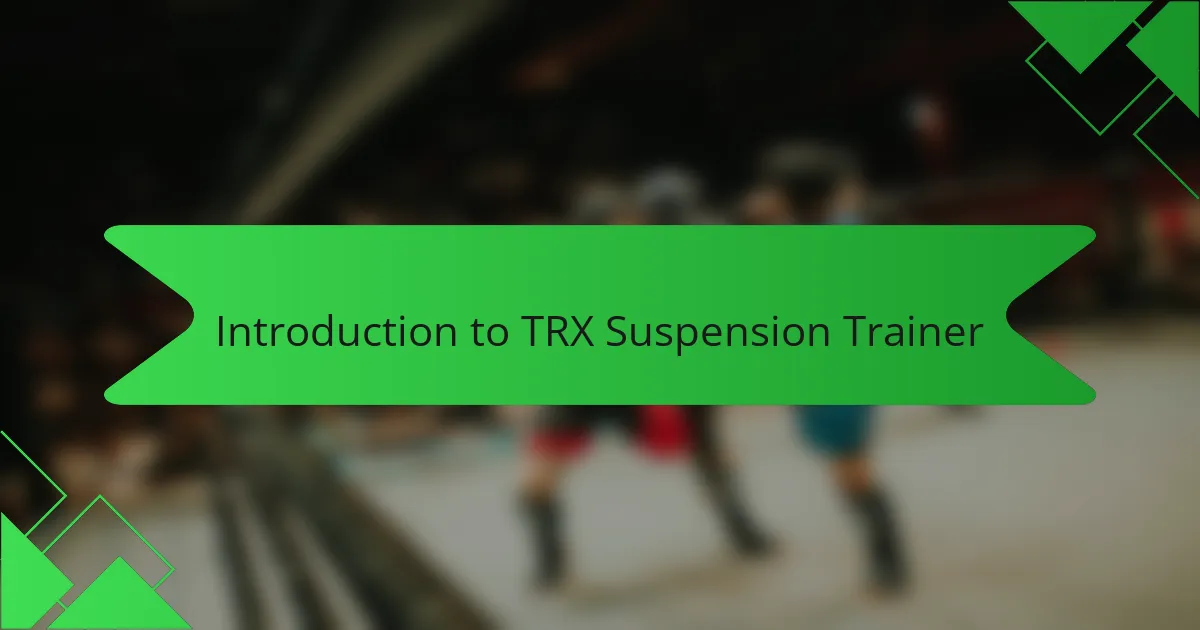Key takeaways
- TRX Suspension Trainer enhances functional strength, balance, and core stability critical for obstacle course racing.
- Key exercises like TRX planks and suspended lunges improve strength, endurance, and agility on uneven terrains.
- Focusing on controlled movements and progressive difficulty boosts performance while addressing muscle imbalances.
- Its portability and versatility make the TRX an excellent training tool, fitting seamlessly into various workout routines.

Introduction to TRX Suspension Trainer
The TRX Suspension Trainer is a simple yet powerful piece of equipment that uses your body weight to build strength, balance, and flexibility. When I first tried it, I was surprised by how challenging small movements became when suspended in mid-air. Have you ever wondered how such a lightweight setup can deliver a full-body workout?

Benefits of TRX for Obstacle Course Racing
When I first incorporated the TRX suspension trainer into my obstacle course racing routine, I immediately noticed improvements in my functional strength and endurance. The ability to use my own body weight in a variety of angles made my muscle engagement feel more natural and race-specific, which really helped me tackle tough obstacles with greater confidence.
One of the biggest benefits I’ve experienced is enhanced core stability, which is crucial for maintaining balance on uneven terrain and during dynamic movements on the course. The TRX’s versatility also allowed me to focus on mobility and flexibility, reducing the chance of injury as training intensified.
- Builds full-body strength using body weight
- Improves core stability essential for balance
- Enhances grip strength for obstacles like monkey bars
- Increases mobility and flexibility to prevent injuries
- Offers scalable workouts that adjust to fitness level
- Boosts endurance through dynamic, functional movements

How TRX Improves Functional Strength
What really stands out to me about the TRX is how it pushes your muscles to work together in a way that mimics real-life movements. Instead of isolating muscles like traditional weight machines, it forces your body to recruit stabilizers—the small, often overlooked muscles that keep you balanced during obstacle runs. Have you ever felt wobbly trying to hold a plank or climb a tricky wall? That’s exactly the kind of functional strength TRX builds.
I remember the first time I did a TRX row; my entire upper body engaged differently than with a standard pull-up. The suspension meant my core tightened to keep me steady, and my grip had to work harder too. It felt like I wasn’t just getting stronger in one spot—I was becoming more coordinated, balanced, and ready for the unpredictable demands of racing.
It’s this blend of strength, stability, and mobility that makes the TRX such a game-changer for obstacle course enthusiasts. It’s not just about lifting heavier weights; it’s about training your body to perform as one unit, ready for any challenge the course throws your way. Wouldn’t you agree that functional strength is what truly separates a seasoned racer from a casual runner?

Effective TRX Exercises for Racing
Effective TRX exercises can truly transform your obstacle course racing performance by enhancing strength, stability, and endurance. From my experience, moves like the TRX plank and suspended lunges not only challenge your core but also simulate the grip and balance demands you face on the course. These exercises feel tough at first, but once mastered, they give you that extra edge when clambering over walls or navigating tricky terrains.
| Exercise | Benefits for Racing |
|---|---|
| TRX Plank | Builds core stability and endurance, critical for maintaining posture during obstacles |
| Suspended Lunges | Enhances single-leg strength and balance, improving agility on uneven surfaces |
| TRX Rows | Develops upper body pulling strength, essential for rope climbs and monkey bars |

Personal Experience Using TRX
Using the TRX suspension trainer quickly became a personal favorite in my training routine. I vividly recall the first time I attempted the suspended push-up; feeling my core constantly engaged made me realize just how much I’d been neglecting those stabilizer muscles before. Have you ever noticed how some exercises make you feel alive, like every fiber in your body is working together? That was exactly the case with TRX.
Over time, I found that the TRX challenged me in ways traditional gym equipment never did. There were moments during sessions when I struggled to maintain balance and control, which initially felt frustrating but became strangely addictive. It’s that ongoing test of coordination and strength that kept me coming back, eager to push through plateaus and unlock new levels of performance.
What surprised me most was how portable and versatile the TRX proved to be. I could take it to the park, set it up quickly, and dive into a full-body workout that perfectly complemented my obstacle course training. Have you ever appreciated a tool that fits seamlessly into your lifestyle and actually makes training enjoyable? For me, the TRX is exactly that kind of game-changer.

Training Tips with TRX for Obstacles
When training with the TRX for obstacle racing, I’ve found that focusing on controlled movements is key. It’s tempting to rush through reps, but slowing down helps me really engage the muscles that support stability during obstacles like rope climbs or wall traverses. Have you ever noticed how a deliberate, steady pace can transform a challenging exercise into a strength-building session?
One tip I swear by is progressively adjusting the body angle to scale the difficulty. Early on, I kept my body more vertical to manage the exercises, but as my strength grew, leaning back more intensified the challenge. This gradual increase not only boosted my confidence but also mimicked the varying demands of race obstacles more realistically.
Lastly, mixing in unilateral exercises like single-leg squats or suspended lunges with the TRX has made a huge difference. These moves forced me to confront imbalances and improve my coordination—something that traditional training often misses. Have you considered how strengthening one side of your body at a time might enhance your overall race performance? I certainly wouldn’t train without them now.

Optimizing Obstacle Performance with TRX
Optimizing your obstacle course performance with the TRX suspension trainer has been a game changer for me. Its ability to engage multiple muscle groups simultaneously really translates well to the dynamic movements required on the course. I remember struggling with grip strength and core control until I integrated TRX exercises, which made climbs and traverses feel significantly easier.
| Aspect | TRX Suspension Trainer |
|---|---|
| Core Engagement | High – Requires constant stabilization |
| Grip Strength | Improves significantly through hanging and pulling movements |
| Versatility | Extremely versatile, targets endurance, strength, and flexibility |
| Portability | Lightweight and easy to set up anywhere |
| Obstacle-Specific Benefits | Prepares for climbing, pulling, and core stabilization challenges |
